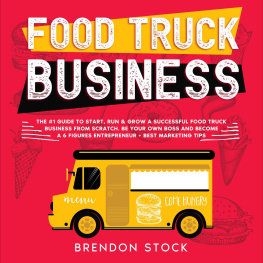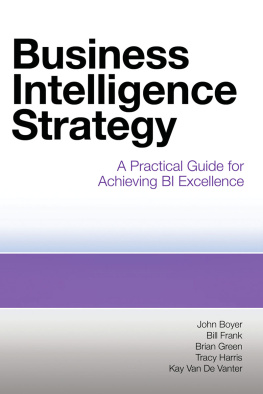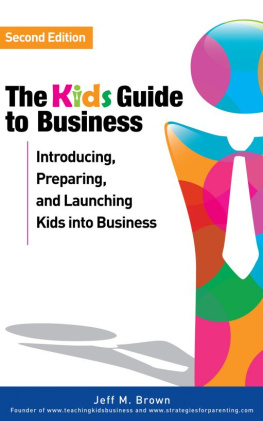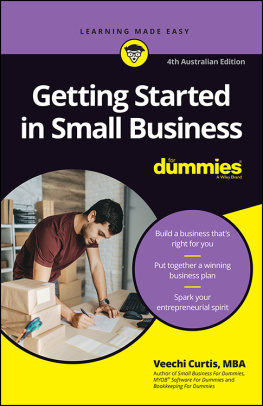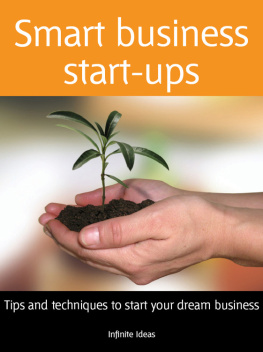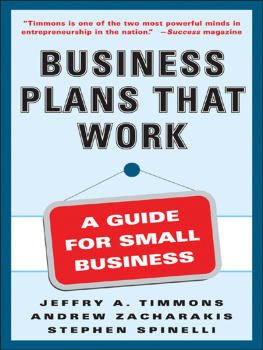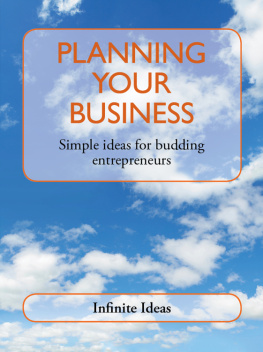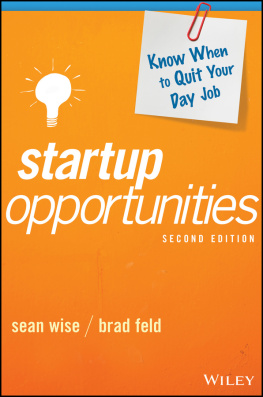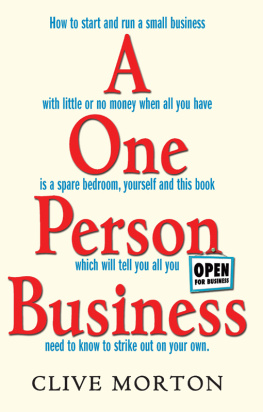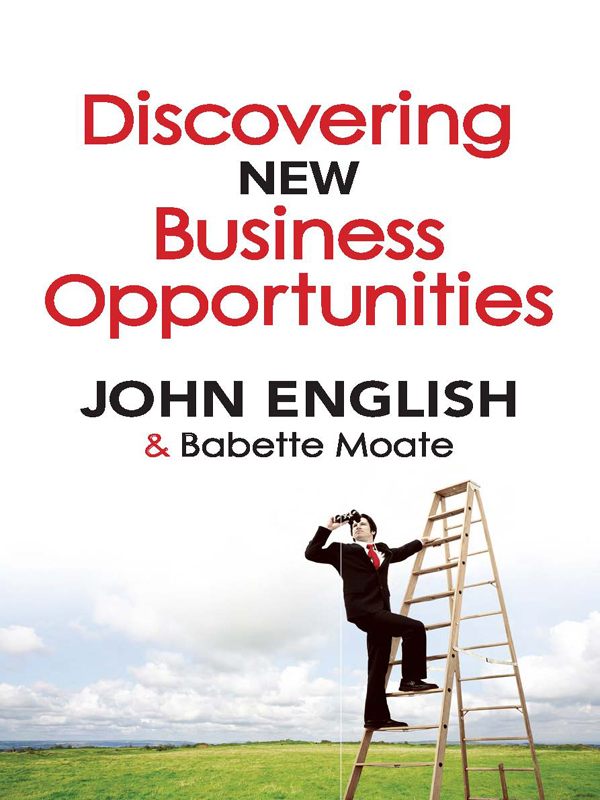
discovering
new
business
opportunities
discovering
new
business
opportunities
JOHN ENGLISH
& babette moate

disclaimer
The information contained in this book is to the best of the authors and the publishers knowledge true and correct. Every effort has been made to ensure its accuracy. Neither the authors nor the publisher accept any liability for any loss, injury or damage caused to any person acting as a result of information in this book nor for any errors or omissions.
First published in 2009
Copyright John English and Babette Moate 2009
All rights reserved. No part of this book may be reproduced or transmitted in anyform or by any means, electronic or mechanical, including photocopying, recording or by any information storage and retrieval system, without prior permission in writing from the publisher. The Australian Copyright Act 1968 (the Act) allows a maximum of one chapter or 10 per cent of this book, whichever is the greater, to be photocopied by any educational institution for its educational purposes provided that the educational institution (or body that administers it) has given a remuneration notice to Copyright Agency Limited (CAL) under the Act.
Allen & Unwin
83 Alexander Street
Crows Nest NSW 2065
Australia
Phone: (61 2) 8425 0100
Fax: (61 2) 9906 2218
Email: info@allenandunwin.com
Web: www.allenandunwin.com
National Library of Australia
Cataloguing-in-Publication entry:
English, John W., 1944
Discovering new business opportunities / John W. English, Babette Moate.
978 1 74175 740 8 (pbk.)
Includes index.
Bibliography.
New business enterprisesAustralia.
New business enterprisesAustraliaManagement.
Business planningAustralia.
Success in businessAustralia.
Other Authors/Contributors: Moate, Babette.
658.0220994
Typeset in 12/14.5 Minion by Midland Typesetters, Australia
Printed and bound in Australia by Griffin Press
10 9 8 7 6 5 4 3 2 1
Contents
Discovering New Business Opportunities has been written to show you how to identify new business ideas and sharpen your judgement about which ones are worth pursuing. The emphasis is on smaller businesses, but the principles apply equally to businesses of all sizes. You can also use the information in this book in other ways. You can use it to help you improve the commercial potential of a business opportunity. You can use it to re-evaluate a business opportunity whenever you decide to change the way you approach it. And you can use it as a framework for explaining a business opportunity to people who are in a position to help you.
The book is divided into five parts:
Part A examines the nature of a business opportunity. It explores the key components of a successful business opportunity, how change creates business opportunities, the diversity of business opportunities and the rise of the solo business.
Part B looks at ways to identify a viable market. It examines criteria for evaluating the potential demand for your idea, how the market will receive your idea and the competitive strength of your idea.
Part C is concerned with anticipating the risks associated with your idea. There are boundary risks, such as legal requirements or changes in technology, that might constrain its commercial potential and establishment risks, such as financial and personal pressures, that might impede the start-up process.
Part D is devoted to finding the right business model. It focuses on the skills and experience needed to put your idea into operation, the resources required to underpin it and the financial outcomes you can expect.
Part E guides you through a technique for judging the commercial feasibility of a new business opportunity. It walks you through the evaluation process, provides a method for assessing commercial feasibility and offers suggestions for constructing a start-up strategy and writing a business plan.
Having a structured method with which you can assess a new business opportunity is enormously valuable. Some people believe that the leap from a new idea to market entry is only a short distance and they often dont recognise how complex, costly and time consuming the process can be. The result is that many people go into business blindly and postpone the day of reckoning until the cost of failure is very high. This is why it is important to assess the commercial feasibility of your idea very early. With the method outlined in this book you can make an early assessment and thus decide if your idea has enough commercial potential to take the plunge.
Discovering New Business Opportunities draws on many years of teaching and research into business start-ups. Former university students have inspired me to find fresh and informative approaches to learning about entrepreneurship and small business development. Hundreds of IDEAS workshop participants have contributed toward refining the method used in this book. I am grateful to my collaborator and co-author, Babette Moate, for her insight into contemporary business opportunities and her ruthless editing. I also thank the University of Tasmania and in particular my colleagues at the Australian Innovation Research Centre for their encouragement.
John English
Part A
BUSINESS OPPORTUNITIES
1 What is a business opportunity?
2 The diversity of business opportunities
A business opportunity is an idea with compelling commercial potential. Most of us have seen or imagined ideas that we might turn into a business. Some ideas have the potential to be commercially successful and others do not. The question we answer in this book is how do we tell them apart. You will know the difference between an idea and a real business opportunity when you can confidently answer yes to three BIG questions:
Can you identify evidence of a viable market?
Can you anticipate the risks involved?
Do you have a business model that makes sense?
A business opportunity is not a guarantee of success but it does represent a likely prospect for creating a successful business. In the chapters that follow, we will explore how to uncover ideas for new business opportunities and how to evaluate them for their commercial potential. In this first chapter, each of the three BIG questions is explained, the ways in which change creates new business opportunities are investigated and the rise of the solo business is examined.
The first BIG question asks if you can identify evidence of a viable market. A viable market is one in which there are good prospects for potential demand, confirmation of market approval and a sound competitive position for your idea.
Potential demand is one of the most important elements in evaluating an idea, and it is also one of the most difficult to assess because it requires some understanding of customer behaviour. Its not about forecasting sales at this early stage; its about painting a picture of the factors that push demand. What can we learn about the relative size of the potential market? Is the potential market increasing or decreasing? Will the demand trend be stable or unstable? How long will demand for this idea last? What scope is there to extend this idea into other products or services? Chapter 3 focuses on key potential demand questions.
Market approval is important in converting potential demand into sales. It affects the rate of adoption and the extent to which the market can be penetrated. There are a variety of reasons why customers may accept or reject a new idea. Does it fulfil a genuine need? Can they easily understand the benefits? Is it compatible with their existing attitudes or patterns of use? Is it complicated for customers to consume or use it? Will it be difficult or costly to organise a way to distribute it? Chapter 4 investigates important questions about market approval.
Next page

